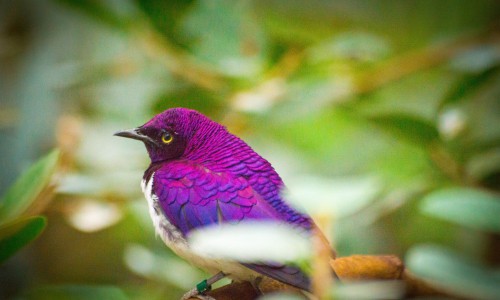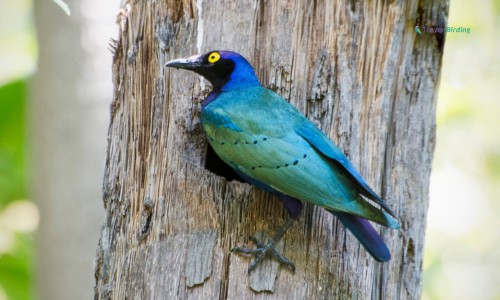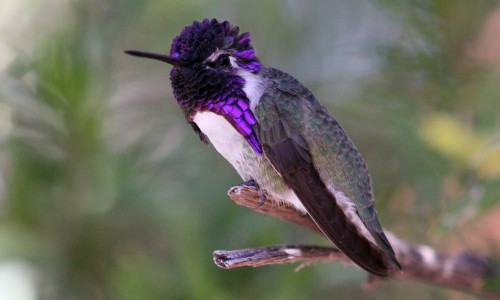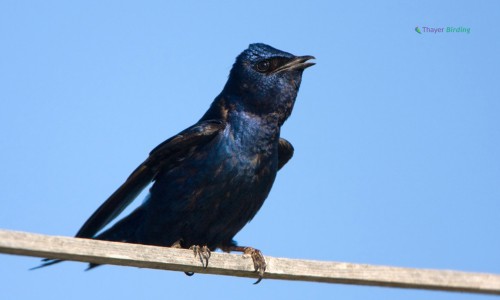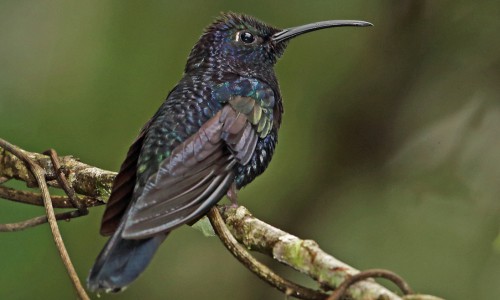It is not unusual to see purple-colored birds in animated movies, but how about in real life? Although they’re not as common as brown, white, and black, there are still several types of purple birds in the wild.
A few notable birds with purple plumage are violet-backed starlings, purple starlings, Costa’s hummingbirds, purple-winged rollers, purple Martins, and violet sabrewing.
Keep reading to find out more about rare purple birds that bring a bit more color to our environment. Let’s get started!
Table of Contents
- Types of Purple Birds
- 1. Violet-backed Starling
- 2. Purple Starling
- 3. Costa’s Hummingbird
- 4. Purple-winged Roller
- 5. Purple Martin
- 6. White-breasted Ground Dove
- 7. Violet Sabrewing
- 8. Lilac-breasted Roller
- 9. Purple-crowned Fairywren
- 10. Purple-backed Thornbill
- 11. Violet-Crowned Woodnymph
- 12. Gray-Headed Swamphen
- 13. Purple Honeycreeper
- Conclusion
Types of Purple Birds
Before we proceed to our list, let’s first find out what purple bird means. Purple feathers are generally linked to creativity, dignity, communication, healing, and spiritual awakening.
The apparent color paired with the name easily recognized purple bird names. Not all of these avian species are purple from head to foot since some only have patches of purple or plumage that appear purple under the light. Take a closer look at them!
1. Violet-backed Starling
Scientific Name: Cinnyricinclus leucogaster
Weight Range: 39 to 56 grams
Approximate Length: 17 to 18 centimeters
Also referred to as Amethyst Starling and Plum-colored Starling, the Violet-backed Starling is famous for its vivid and iridescent feathers. Although both sexes share the black beak and legs and yellow eyes, their plumage colors are noticeably different:
- The males have violet upper parts and white underparts
- Females have streaky brown upperparts and white underparts with brown stripes.
These small violet birds inhabit clearings, open woodlands, and gallery forests of sub-Saharan Africa, finding warmth in these habitats when it gets cold in the south. When it’s not mating season, you can spot these birds in flocks.
Violet-backed Starlings stay on trees and are seldom seen on the ground. If there is a swarm of termites, you can be sure to find these birds around stuffing themselves until full.
2. Purple Starling
Scientific Name: Lamprotornis purpureus
Weight Range: 91 to 140 grams
Approximate Length: 22 to 23 centimeters
Purple Starlings, sometimes called Purple Glossy Starlings, are stocky birds with shiny green wings. Both males and females have the same yellow eyes, short tails, and purple bodies. However, juveniles are different with their brown eyes and gray underparts.
This bird with purple feathers is native to tropical Africa. They frequent open woodlands and agricultural areas from Senegal to West Kenya.
Purple Starlings are non-migrating terrestrial animals that make their presence known through their noisy squeaks and chattering. Their diet consists of insects and fruits.
3. Costa’s Hummingbird
Scientific Name: Calypte costae
Weight Range: 3 to 3.2 grams
Approximate Length: 7.6 to 9 centimeters
Wingspan: 11 centimeters
These small birds have short tails and wings that narrowly miss each other when the bird is perched. You can tell these birds’ gender apart by their plumage color:
- Male Costa’s Hummingbirds are famous for their purple crown and throat patch that looks like a mustache.
- Females and juveniles can be distinguished by their white underparts and gray-green upper parts.
Costa’s Hummingbirds are abundant in the Sonoran and Mojave Deserts. They prefer gardens and bushy deserts across the US and Mexico, moving to the south when the desert’s heat becomes unbearable.
Like most hummingbirds, these species feed on nectar and insects. Desert plants like ocotillo and chuparosa are Costa’s absolute favorite. Aside from their ability to hover mid-air, these tiny birds can also dive following a curved path while making a high-pitched sound.
4. Purple-winged Roller
Scientific Name: Coracias temminckii
Weight Range: 144 to 164 grams
Approximate Length: 30 to 34 centimeters
Purple-winged Roller is part of the old-world bird family, Coraciidae. Some nicknames given to this bird are Temminck’s Roller, Celebes Roller, and Sulawesi Roller. These birds have purple wings, dark-olive backs, and bright blue caps and tails coverts.
True to one of its monikers, this species can only be found in the Sulawesi subregion of Indonesia. You can find them in tropical and subtropical lowland forests, where they hunt for lizards, locusts, beetles, and grasshoppers.
5. Purple Martin
Scientific Name: Progne subis
Weight Range: 45 to 60 grams
Approximate Length: 19 to 21.5 centimeters
Wingspan: 39 to 41 centimeters
This dark purple bird is the largest in its Hirundinidae family. It feature different plumage color, depending on the sexes:
- Male Purple Martins have black wings and tails and deep bluish-purple plumage that appears vivid purple under a light source.
- Females, on the other hand, are pale gray-white and have lighter underparts.
Purple Martins prefer staying near humans, frequenting open areas, parks, and wet meadows. They would migrate long distances that extend from North America to the South when the temperature drops.
These birds are recognized for their agility and speed. They look like doing aerial acrobatics mid-air, a combination of gliding and flapping, to catch flying insects. Fast diving is also another thing the species excels at.
6. White-breasted Ground Dove
Scientific Name: Pampuna jobiensis
Weight Range: 126 to 156 grams
Approximate Length: 25 centimeters
Also called the White-Bibbed Ground Dove because of its white breast feathers, the species also feature distinct purple upper parts and shoulders. Females have similar plumage color as males, only paler.
These white and purple birds occur in lower montane forests and foothills of the Bismarck Archipelago, the Solomon Islands, and New Guinea. White-breasted Ground Doves are nomadic and will feed on seeding bamboo, seeds, and berries scattered on the ground.
These doves possess distinct deep yet flat calls, which are a series of hooping notes that sometimes sound like a frog croaking.
7. Violet Sabrewing
Scientific Name: Campylopterus hemileucurus
Weight Range: 9 to 12 grams
Approximate Length: 15 centimeters
Wingspan: 8.2 centimeter
This large hummingbird is easily recognized with their bent-down beaks and long tails. Males are purple all over except for their green backs. Females are only purple in the throat area, whereas the rest of their bodies are green.
Violet Sabrewing’s habitat is in the forests, grasslands, and tropical coastal regions of Costa Rica, Mexico, and Panama. They remain in this range, enjoying the consistent climate and food sources throughout the year.
These birds play an important role in pollinating trees in several coffee plantations, so their absence will cause lesser coffee production.
8. Lilac-breasted Roller
Scientific Name: Coracias caudatus
Weight Range: 104 grams
Approximate Length: 36 to 38 centimeters
Wingspan: 50 to 58 centimeters
Lilac-breasted Rollers are large-headed African birds. These birds are not sexually dysmorphic, so both females and males have short necks, faded green heads, violet breasts and rumps, brown backs and shoulders, and green-yellow legs.
This light purple bird is native to Eastern and Southern Africa, sometimes wandering in the southern Arabian Peninsula. You can spot them in savannas and open woodlands with lots of trees and shrubs. A part of their population migrates to northwest Somalia for the mating season, while others stay in their range.
Lilac-breasted Rollers are either alone or in pair when you see them in the wild, perching on high trees on the lookout for their prey. They stay away from human-influenced areas and places without trees.
9. Purple-crowned Fairywren
Scientific Name: Malurus coronatus
Weight Range: 9 to 13 grams
Approximate Length: 14 centimeters
Wingspan: 16 centimeters
These birds with purple heads are often confused with their relatives, the splendid fairywren and superb fairywren. Purple-crowned Fairywren’s distinct features that set it apart from others are the dark blue tail and cheek patches, which are red for males and reddish-brown for females.
Purple-crowned Fairywren is an indigenous bird in Australia; living in the wet tropics with dense vegetation. They are not well adapted to urbanized areas since a huge population of these birds was lost in these places.
These birds are monogamous, rarely pairing with other mates. Offsprings from previous broods stay with adults to help raise the new broods, which increases the chances of survival for these species.
10. Purple-backed Thornbill

Scientific Name: Ramphomicron microrhynchum
Weight Range: 3.5 grams
Approximate Length: 8 to 9 centimeters
This small bird has the shortest bill among all hummingbird species. You can easily tell females and males apart by examining the bird’s feathers:
- Males have distinct purple backs, green throats, purple and black notched tails, and white eye spots.
- Females set themselves apart with their greenbacks and shorter and not-so-notched tails.
Purple-backed Thornbills can be found from west Venezuela to Peru. They live in flowering trees and treelines bordering the elvish humid forest of the Andes. These birds stay in their tropical and subtropical range and do not migrate.
These hummingbirds descend to lower elevations in the dry season and move up to higher elevations during the wet season. You can find the bird foraging from one canopy to another, trap-lining floral food sources nearby.
11. Violet-Crowned Woodnymph
Scientific Name: Thalurania colombica
Weight Range: 3.5 to 5.5 grams
Approximate Length: 9.5 to 11.5 centimeters
More commonly referred to as Crowned Woodnymph, these hummingbirds are known for their long beaks and skinny bodies. Like many species on this list, the violet-crowned woodnymph are sexually dysmorphic:
- Males have shiny green throats and chests, bronze-green lower backs and napes, deep blue-green backsides, and violet in the rest of their body parts.
- Females have violet crowns, gray chest and throat, pale green underside, and vivid green upper parts.
Violet-Crowned Woodnymphs live in the north end of South America from northern Peru, Guatemala, and Belize. They occur in semi-open landscapes, humid forests, wet lowlands, and foothills. When not mating, they prefer the higher elevation.
The main diet of these hummingbirds is nectar, and they get it from a wide variety of flowing plants in their range. They also forage for small arthropods, gleaning foliage in search of them.
12. Gray-Headed Swamphen
Scientific Name: Porphyrio poliocephalus
Weight Range: 505 to 850 grams
Approximate Length: 38 to 50 centimeters
Wingspan: 90 to 100 centimeters
The Gray-headed Swamphen might be a small waterfowl in its Rallidae family, but it is the biggest rail in North America. There is no sexual dimorphism between males and females. Both have a red beak, a red spot between the eyes, white underparts, and a purple and cobalt blue mix for the rest of their bodies.
This swamphen is native to northern Thailand, the Middle East, southern China, and Indian subcontinents. The species can also be found in marshes, artificial wetlands, and loughs of southern Florida after the birds escaped in the 1990s. Now they have bred and multiplied enough to be added to the American Birding Association’s list.
Gray-headed Swamphens are hostile birds and are a serious threat to the native rails of North America. When food sources are scarce, they can disperse far, extending to South Carolina and Georgia.
13. Purple Honeycreeper
Scientific Name: Cyanerpes caeruleus
Weight Range: 12 grams
Approximate Length: 10.5 to 11 centimeters
This small Neotropical bird is a member of the Tanager family and is sexually dysmorphic:
- Males are distinct from females with their black wings and beak and the vivid purple and blue plumage on the rest of their bodies.
- On the other hand, females have red head feathers and green bodies, which helps them camouflage their surroundings.
Purple Honeycreepers are indigenous species in the lowland forest shades and plantations of northern South America. These birds also occur throughout the Amazon rainforest, Columbia, Bolivia, Ecuador, and Brazil. You can find them all year round in their range since they don’t migrate.
These rainforest birds spend time in small flocks. They also socialize with other bird species.
Conclusion
What do you think of these types of purple birds? Have you ever seen one like purple birds of paradise? Then you’re lucky, especially when you meet them by chance!
Share your experience with them! What bird did you see and where? There surely are a lot more purple birds that did not make our list. Feel free to add them in the comment section!

As many can agree with me, birdwatching is a thrilling and calm hobby at the same time. Such trips to the parks into deeper parts of the jungle bring me enormous joy seeing the birds through my naked eyes or high-quality camera and binoculars. So, to make such a hobby even more enjoyable to you, beginners or not, I opened this space called Thayerbirding.



